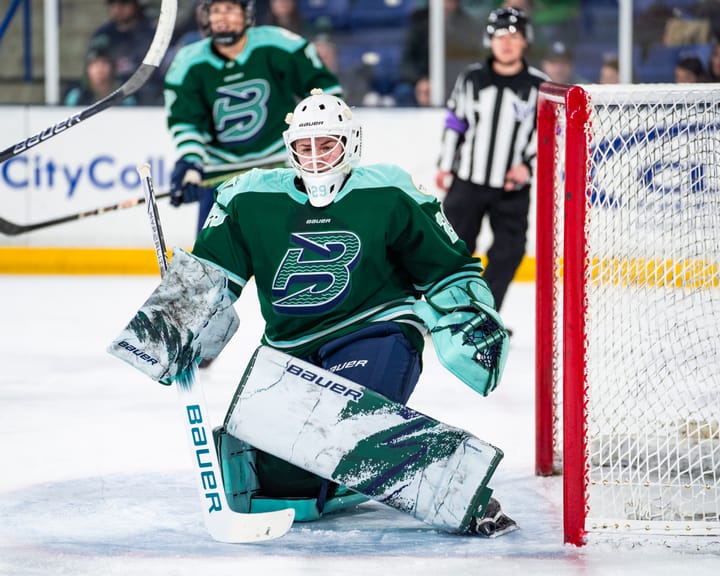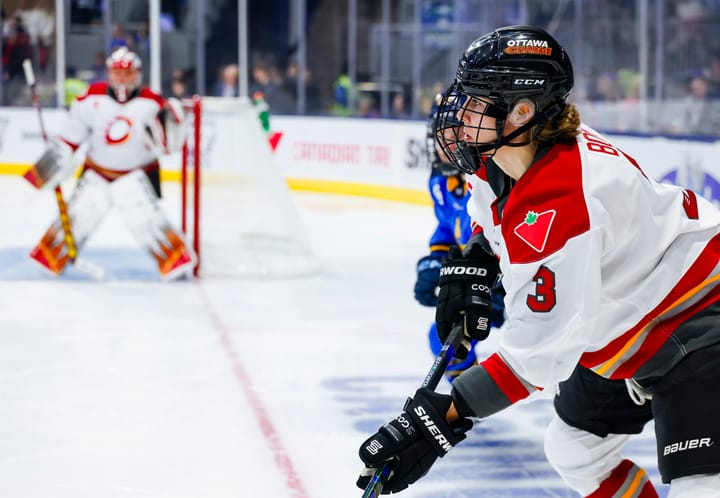How the Whale lost 7-0 in the Isobel Cup Semifinal
And why we can’t judge a team by one bad loss
Before the Connecticut Whale met the Minnesota Whitecaps in the Isobel Cup Semifinal, I wrote that they had both the will and the skill to win and advance to their first Isobel Cup Final. And then they lost. By a score of 7-0.
I know what you’re all thinking. Here comes Mike’s defense of the Whale after they got blown out in a must-win game. He’s going to bring up how single-game elimination playoffs are brutal, how the Whale never recovered from the disallowed Friesen goal, and how hockey can be cruel because it’s a fast, unforgiving game influenced heavily by bounces and things that are difficult to quantify. Well, yeah. All of those points are valid but here’s the other thing: the Whale didn’t play that poorly.
Let me explain.
In case you missed it, you can gain a lot of insight into what the Whale’s gameplan was from Jack Han’s newsletter. Connecticut knew they had a tough matchup with the Whitecaps. They chose to play aggressively to generate as many shots and chances as possible against a team with a reputation for being lethal on the rush.
We all know the final score but let’s look at some of the underlying numbers of the Isobel Cup Semifinal showdown between the Whale and the Whitecaps.
Shots and Chances
The Whale out-shot the Whitecaps by a good margin. The NWHL’s box score had the shots at 44 to 31 but InStat’s data had them at 50 to 33. Either way, the Whale put more rubber on net than the Whitecaps, which reflects the execution of their gameplan heading into the semifinal. Connecticut also had more scoring chances, to the tune of a +13 differential (33-20) at even strength.
It’s important to note that there was only one minor penalty called in the game — a tripping call on Minnesota’s Winny Brodt Brown in the third — so this semifinal was played almost exclusively at evens. The refs definitely called this one like a playoff game, which probably worked in the Whale’s favor. They are a physical team with an aggressive forecheck and the Whitecaps had a hot power play in Lake Placid.
A look at Alyssa Longmuir’s Shot Ladder chart from the semifinal illustrates how the Whale lost their steam after pouring shots on in the first 40 minutes. Maybe that was a result of feeling frustrated by Friesen’s disallowed goal — which was undoubtedly a controversial call — and being down 5-0 after two periods, or maybe it the cost of coming out of the gates with the pedal to the metal after weeks without playing a game. In all likelihood, it was a bit of both. Going by the NWHL’s box score, the Whale had 33 shots in the first two periods and just 10 in the final chapter of the game.
It wouldn’t be unfair to say the Whale likely felt they were defeated before the third period began. Connecticut faced the task of scoring five goals in twenty minutes on Amanda Leveille in a playoff game. It would be understandable if some of the Whale lost their steam especially after watching Lev turn aside over 30 shots in the first two periods. That’s not to say that they gave up, because they certainly didn’t, but there was simply too much of a mountain to climb in twenty minutes.
Not to bring the sad tweets but if you want to see the whale bleed out in chart form the 3rd period here causes me physical pain pic.twitter.com/Bvcefq5qyg
— Alyssa (@alyssastweeting) March 27, 2021
Per InStat’s data, the Whale had 4.15 xG (expected goals) at even strength compared to Minnesota’s 4.4 xG. Those numbers, along with the shot differential and the 12:26 the Whale spent in the offensive zone versus the 12:20 the Whitecaps spent in the offensive zone, suggest that this game was far closer than its final score even with the Whale losing steam in the third.
So, if this game was closer than it looked how did the Whale lose by seven goals?
Goaltending
The real story of this game was Leveille. Call it a 44-save shutout or a 50-save shutout, either way, she was brilliant. Her reaction to hearing she stopped 44 shots spread like wildfire on social media because it was classic wholesome Lev but it also suggests just how much she was lost in her groove. And when a goalie as good as Leveille gets into a groove, it is bad news for the opposition.
LEV CAN’T EVEN BELIEVE
— Lindsey Brown (@lindseybrown35) March 27, 2021
WHAT LEV JUST DID pic.twitter.com/1qyfkoEg1e
Credit also belongs to Minnesota’s defense. They succeeded in keeping Connecticut’s shots to the outside — we'll get into this more in a bit — and cleaned up any rebounds that their All-Star goalie left hanging. They were sharp in their own zone and helped facilitate the counter-attack that proved to be all Minnesota would need to win this game.
As for Ives, she’d likely be the first to tell you that this wasn’t her best game. She finished with a .774 Sv% against an xGA of 4.4. With that said, she wasn’t the main reason the Whale lost — after all, you can’t win if you don’t score a goal. But Ives was part of the reason why Connecticut didn’t win.
All seven of Minnesota’s goals were a direct result of an attack on the rush and/or defensive breakdowns in the slot. You simply can’t afford to leave players open right in front of the net and the Whale did that on several occasions against the Whitecaps.
The first two goals of the game for Minnesota illustrate the breakdowns that, at times, were a direct result of the Whale’s aggression. On Minnesota’s first goal, Audra Richards hunted down her own dump-in before getting some support behind the net from Nina Rodgers who made a slick pass to the slot from behind the goal line to a wide-open Haylea Schmid. Watch Nicole Guagliardo look over her right shoulder and lose track of Schmid slipping behind her into the slot to receive Rodgers’ pass. A brief lapse in coverage and boom, it’s 1-0.
On Minnesota’s second goal, Allie Thunstrom’s speed burns the Whale. Just moments before scoring this breakaway goal Thunstrom was stoned on a breakaway doing the same move by Ives. So, what more is a goalie supposed to do? This is a frustrating clip to watch for Whale fans because the puck seems to skip its way through Tori Howran and the Whale’s defense before deciding to behave once Thunstrom pounced on it to go one-on-one against Ives.
It’s easy to second-guess starting Ives over Brooke Wolejko and/or keeping her in after trailing 5-0 at the end of the second period. It’s easy to second-guess a lot of things after a 7-0 loss. But it’s important to remember that Laura Brennan was the Whale’s head coach for this game. Brennan, a goalie herself, has forgotten more about goaltending and the psychology of the position than most of us will learn in a lifetime. Connecticut had complete confidence in Abbie Ives. They needed Ives to play her best hockey and, at the end of the day, she didn’t.
This is the kind of thing that happens when you have single-elimination playoffs.
The Whale’s breakdowns in coverage ultimately proved to be too much for their goaltender to make up for. Still, the Whale collectively blocked 15 shots in this game compared to Minnesota’s 14. They definitely didn’t quit on their goaltender.
Quantity vs Quality
So, we’ve established that the Whale attempted more shots, put more shots on goal, and had more scoring chances than the Whitecaps. Now let’s look at where those shots and chances came from and why this game is such a potent example of how important it is to strike a balance between generating quality and a high quantity of chances in a hockey game.
First, let’s look at Connecticut.
Here’s their shot chart from the Isobel Cup semifinal. Take note of how many shots they attempted from the blue line. In Lake Placid, Whale captain Shannon Doyle talked about how Connecticut’s defenders were focused on getting point shots through the “first layer” of traffic in front of the net. In theory, this was not a bad approach to getting pucks past Leveille in the semis. Every goalie struggles to stop pucks when they can’t see where they are coming from and the Whale were sending skaters to the net in pursuit of rebounds.
Key: x = a shot that missed the net or was blocked, black dot = a shot on goal
The shot chart above also reveals how few shots the Whale attempted from the slot. For the most part, Connecticut’s chances came from the outside. The Whale managed to get some shots on Leveille from in tight but not nearly as much as the Whitecaps had against Ives. Leveille had solid rebound management and the defenders in front of her did a great job tying up sticks. The result was a frustrated group of Whale forwards that were likely robbed of the only puck they managed to get past Lev.
Now let’s look at Minnesota’s shot chart — something should jump out to you right away.
Look at where five of Minnesota’s seven goals were scored from. Right in front of the net. Of course, a few of those were the result of goals scored on the rush, but not all of them were. The Whale were guilty of some costly lapses in coverage in their own zone. Minnesota’s first goal of the game, scored by Haylea Schmid, was a good example of this. Somehow Schmid went unchecked when she glided into the slot to receive a beautiful pass from behind the goal line by Nina Rodgers.
The Whale entered the semis fully aware of what made the Whitecaps so dangerous as a counter-attacking team and Minnesota still managed to burn them. At the end of the day, the Whitecaps deserve full marks for playing Whitecaps hockey. They used their speed and executed beautifully on the rush. Furthermore, they found success in the cycle and got the puck into areas where their talented forwards could challenge Ives.
Reflections
If you’re a Whale fan kudos to you for reading this far. I wouldn’t blame you for wanting to shake your head like an Etch-a-Sketch and forget about this one. But there is something to be learned here. The Whale tried something in this game and, ultimately, it didn’t work. That doesn’t mean they had a bad plan. It means they lost a hockey game. They accomplished much of what they set out to do but, for whatever reason, came away empty-handed.
That’s hockey.
It’s a shame that this game had such a lopsided score because it likely misled fans who were watching their first NWHL game on national television about the parity of the league and what the Whale were capable of. This was a very good Connecticut team. We shouldn’t rush to judge them on the outcome of one game where the opposition enjoyed a 22.5 shooting percentage.
If this was a three or five-game series, you’d simply burn this tape and move on to the next game. But it was a one-game series. Just like they planned, the Whale got more shots and chances on net than the Whitecaps but the puck just didn’t go in. They were staggeringly unlucky. They also ran into a hot goaltender and a swift, experienced, and confident group of forwards led by a healthy Allie Thunstrom. That’s why they lost.
Data courtesy of InStat. Charts courtesy of Alyssa Longmuir and InStat.





Comments ()